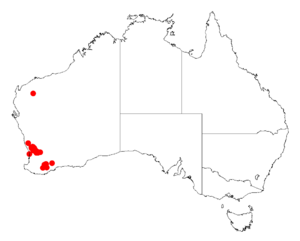Acacia crassistipula facts for kids
Quick facts for kids Acacia crassistipula |
|
|---|---|
| Scientific classification | |
| Genus: |
Acacia
|
| Species: |
crassistipula
|
 |
|
| Occurrence data from AVH | |
Acacia crassistipula is a type of shrub. It belongs to the large group of plants called Acacias. This special shrub only grows in western Australia. This means it is endemic to that area.
What Does It Look Like?
This shrub usually grows low to the ground. It can be about 0.1 to 0.5 meters (about 4 inches to 1.5 feet) tall. Its branches have ribs and might have tiny hairs. It has special leaf-like parts called stipules. These are about 2 to 7 millimeters long.
The leaves of this plant are called phyllodes. They stand upright and are green. They are not perfectly even on both sides. Their shape is like a narrow oval. These hairy phyllodes are about 7 to 16 millimeters long. They are also about 1.5 to 3 millimeters wide. Each phyllode has one main vein. Other smaller veins are hard to see.
Acacia crassistipula blooms in July and August. It produces bright yellow flowers. These flowers grow in simple groups. Each group is found alone where a leaf meets the stem. The flower-heads are round or slightly oval. They are about 5 to 6 millimeters across. Each head is packed with 27 to 33 golden flowers.
After the flowers, seed pods grow. These pods are brown and a bit leathery. They are long and narrow. They can be wavy or curved. The pods are about 4 centimeters long and 3 to 5 millimeters wide. Inside, they hold shiny, dark brown seeds. These seeds are oval-shaped and about 2 to 3 millimeters long.
How Was It Named?
The first official description of this plant was made in 1842. A botanist named George Bentham described it. This was part of a larger work by William Jackson Hooker. The work was called Notes on Mimoseae, with a synopsis of species. It was published in the London Journal of Botany.
Later, in 2003, another botanist named Leslie Pedley changed its name. He reclassified it as Racosperma crassistipulum. But in 2006, it was moved back to the Acacia group.
Where Does It Grow?
This shrub is native to western Australia. It grows in the Great Southern and Wheatbelt regions. It prefers sandy soils that contain lateritic gravel.
The plant's distribution is not continuous. This means it grows in separate areas, not all connected. You can mostly find it from Mogumber in the north. It extends down to York in the south. Smaller groups of these plants also grow further south. These are found between Borden, Tambellup, and Nyabing. They grow in open areas with low shrubs or in open woodlands. These woodlands often have Eucalyptus wandoo trees.

